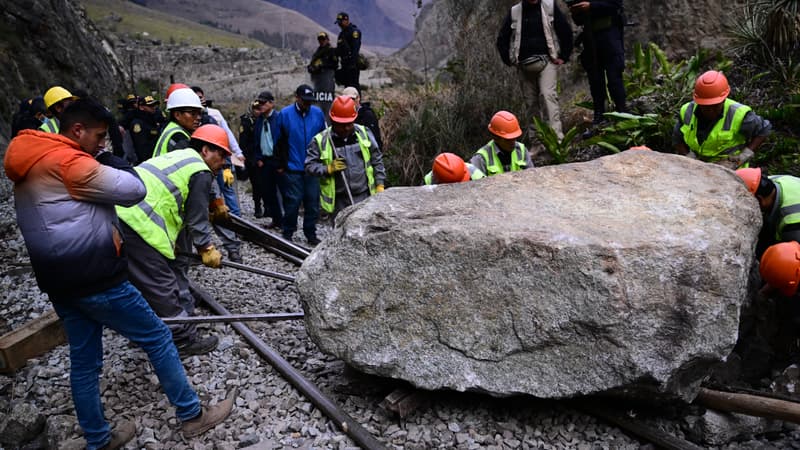“Machu Picchu was great but we will remember more the stressful days that followed. Unforgettable,” laughs Canadian half-fig half-grape Alex Lim, who was one of the first 200 tourists evacuated from the famous Inca site on Saturday, according to an AFP tally on Saturday.
Since December 7, Peru has been agitated by demonstrations that have left at least 19 dead and 569 injured, triggered by the impeachment and arrest of President Pedro Castillo, as well as the rise to power of Dina Boluarte.
Americans, French, Australians, Germans, Peruvians… There were at least 500 who found themselves trapped on Tuesday at the foot of the World Heritage Site, in the small town of Aguas Calientes, according to AFP. CNN table for its part over 300 stranded tourists. In question: a train line cut by protesters.
Blocked for 5 days
The railway is in fact the only means of transportation to get to Aguas Calientes but also to leave. The tourists, therefore, found themselves waiting in uncertainty for 5 days in hotel rooms in the village without their belongings, most of them staying in Cuzco, the Inca imperial city, located 110 km away.
“It was special to have clothes for one day. And therefore do the laundry and wait for it to dry while remaining naked,” laughs Kate Lim, Alex’s wife, interviewed by AFP.
Despite the banter, the couple became very stressed. Alex, 41, who has high blood pressure and needs to take one pill a day, had not taken enough medication. He was finally able to obtain some after a visit from a doctor sent by the authorities.
“We were better informed by other travelers than by local authorities,” he said.
The couple, who had started a “great post-Covid journey”, are reluctant to continue the adventure or return home to Toronto. “We are going to rest, de-stress and we will decide”, summarizes Alex, who points out that, despite the demonstrations, Peruvians have been “welcoming”.
Evacuation after track repair
The authorities began wanting to mount an airlift on Saturday with helicopters but the rain prevented it. Later in the day, “with the support of the police and the armed forces,” “they managed to send a monorail with equipment and men to repair” and clear the 29 kilometers of track between Piscacucho and Aguas Calientes, explained Tourism Minister Luis Fernando Helguero, present at the scene.
Piscacucho, one of the starting points of the Inca Trail, is the closest hamlet that can be reached by road from Aguas Calientes.
“We discovered by chance that this train was leaving Machu Picchu ten minutes before departure. We rushed,” Brazilian Guilherme Bucco, a professor at the University of Porto Alegre, told AFP.
“Aguas Calientes is very nice, but an hour later, you have nothing else to do! So 5 days… I had to cancel a lot of plans and I have to go back to work next week,” she says. “But I’m relieved to be out of there.”
Two kilometer walk on the rails
Another unpleasant surprise awaited the travelers. If the railway workers did their best to repair the track, they could not remove a huge stone enthroned between the rails, thrown from the cliffs by the protesters.
As a result, tourists had to walk some two kilometers after dark over the cobblestones of the railway in the light of mobile phones to join the waiting minivans to take them back to Cuzco.
Although police and railwaymen helped some carry their bags, the steep journey was not easy, especially for the elderly.
American Avis Berney, 77, from Whidbey Island near Seattle, rests on a rock and lifts her spirits with a pun: “My cane saves me! I’m retired and tired (retired and tired).”
“I will never forget the difference between the comfort of life and the comfort of being at home!” he philosophized to AFP.
40 kilometer walk for others
according to the newspaper The worldother tourists did not wait to be evacuated to complete the first 40 kilometers on foot before reaching Cuzco by car.
“At 6 in the morning on Wednesday we started walking towards Ollantaytambo. They told us that it would be from 6 to 8 in the morning but in the end we did 40 km and about 10 in the morning walking”, Vicente and Ana Isabel testified to the Spanish media.
“The first 25 kilometers from Aguas Calientes, we follow the train tracks, with few people. We were a group of 20 people, it was very hot, there was no water to buy, a disaster”, the couple continues.
Then they were able to eat Cuban rice at the home of the locals. But advancing on the road to Cuzco, these Spanish tourists say that tensions with the protesters have been escalating.
“We took a motorcycle, then we walked again, with pickets in the middle, with cut trees, stones, protesters, even peasants on the road,” Vicente and Ana Isabel relate. “When we passed the town of Anta (…) there were already cars that came to pick us up and without paying anything they took us to Cuzco.” But they missed their flight to Spain and were forced to buy a new ticket.
After the headache of the evacuation, the Minister of Tourism crosses his fingers that the demonstrations stop and that “tourism resumes.” “We have calculated a loss of 200 million soles (50 million euros)” due to the events, said Luis Fernando Helguero. And remember that tourism represents between 3 and 4% of GDP and provides employment “to all strata of the economy.”
He was concerned about the damage to the image and perception of the country that tour operators and tourists might have.
Source: BFM TV


